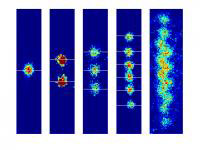New ion trap may lead to large quantum computers

False-color images of 1, 2, 3, 6, and 12 magnesium ions loaded into NIST's new planar ion trap. Red indicates areas of highest fluorescence, or the centers of the ions. As more ions are loaded in the trap, they squeeze closer together, until the 12-ion string falls into a zig-zag formation. Credit: Signe Seidelin and John Chiaverini/NIST
Quantum computers would exploit the unusual behavior of the smallest particles of matter and light. Their theoretical ability to perform vast numbers of operations simultaneously has the potential to solve certain problems, such as breaking data encryption codes or searching large databases, far faster than conventional computers. Ions (electrically charged atoms) are promising candidates for use as quantum bits (qubits) in quantum computers. The NIST team, one of 18 research groups worldwide experimenting with ion qubits, previously has demonstrated at a rudimentary level all the basic building blocks for a quantum computer, including key processes such as error correction, and also has proposed a large-scale architecture.
The new NIST trap is the first functional ion trap in which all electrodes are arranged in one horizontal layer, a “chip-like” geometry that is much easier to manufacture than previous ion traps with two or three layers of electrodes. The new trap, which has gold electrodes that confine ions about 40 micrometers above the electrodes, was constructed using standard microfabrication techniques.
NIST scientists report that their single-layer device can trap a dozen magnesium ions without generating too much heat from electrode voltage fluctuations–also an important factor, because heating has limited the prospects for previous small traps. Microscale traps are desirable because the smaller the trap, the faster the future computer. Work is continuing at NIST and at collaborating industrial and federal labs to build single-layer traps with more complex structures in which perhaps 10 to 15 ions eventually could be manipulated with lasers to carry out logic operations.
Media Contact
All latest news from the category: Physics and Astronomy
This area deals with the fundamental laws and building blocks of nature and how they interact, the properties and the behavior of matter, and research into space and time and their structures.
innovations-report provides in-depth reports and articles on subjects such as astrophysics, laser technologies, nuclear, quantum, particle and solid-state physics, nanotechnologies, planetary research and findings (Mars, Venus) and developments related to the Hubble Telescope.
Newest articles

Detector for continuously monitoring toxic gases
The material could be made as a thin coating to analyze air quality in industrial or home settings over time. Most systems used to detect toxic gases in industrial or…

On the way for an active agent against hepatitis E
In order to infect an organ, viruses need the help of the host cells. “An effective approach is therefore to identify targets in the host that can be manipulated by…

A second chance for new antibiotic agent
Significant attempts 20 years ago… The study focused on the protein peptide deformylase (PDF). Involved in protein maturation processes in cells, PDF is essential for the survival of bacteria. However,…





















